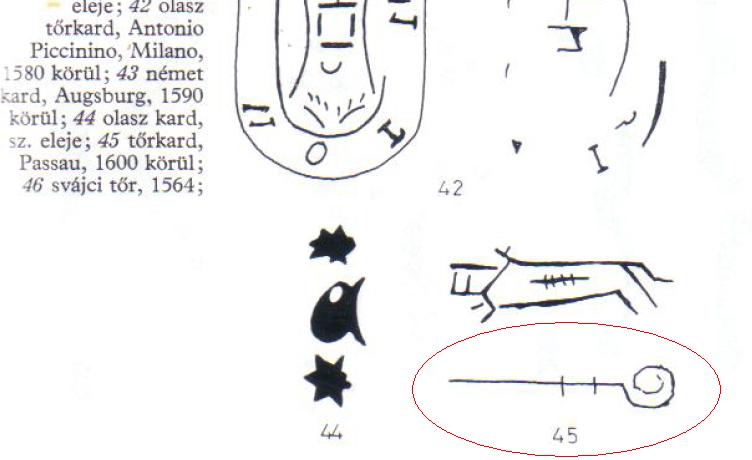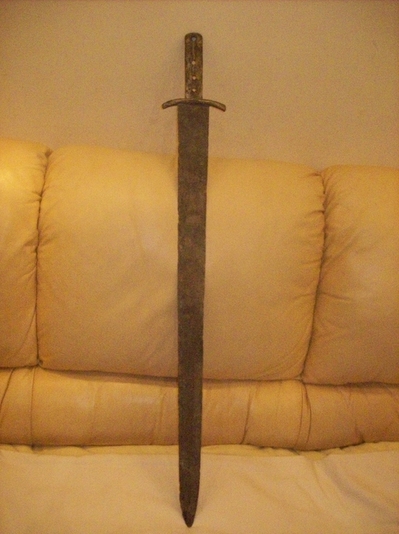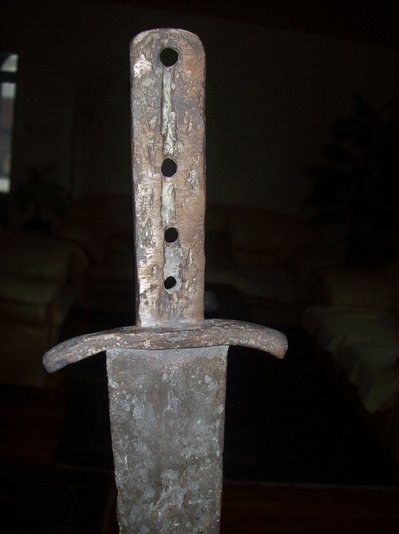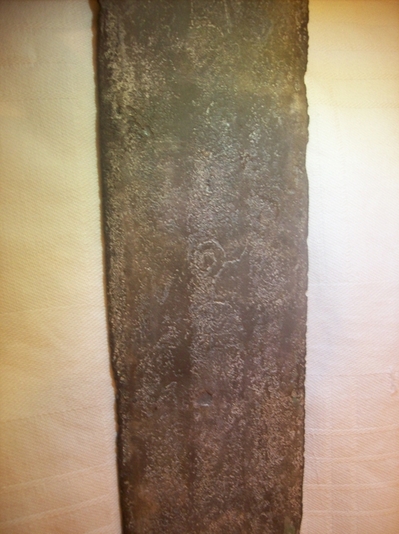Posts: 3
Thu 14 Apr, 2011 1:30 am
a sword
Posts: 1,220 Location: Cork, Ireland
Thu 14 Apr, 2011 3:05 am
Hey Miodrag, first of all I can tell you that this is no viking sword, in fact I would guess that it is much more modern than that. That said, I can't actually tell you what it is, the tang seems to have rivet holes which were a common feature no knives, but not on swords. Perhaps if you were to post some statistics i.e. weight, length, you might have better luck in you'r search.
Posts: 84 Location: Northern VA
Thu 14 Apr, 2011 3:26 am
Looks to me like an
Oakeshott type XXI. The holes in the tang are common on these, since the handles were riveted on. They also tend to have the short wide blades.
For more info on XXI, look here.
http://www.myArmoury.com/feature_spotxxi-xxii.html
I don't recognize the mark.
Good luck!
Posts: 83 Location: Omaha, NE
Thu 14 Apr, 2011 5:14 am
I have to agree that it is not a Viking Age sword. The tang is to wide and has rivet holes, the cross guard is an odd design for that period, and the blade appears to be hexagonal in
cross-section from your pics. That last thing alone makes it alot newer that the Viking Age. Definitely could use some stats on it to help identify it better.
Posts: 9,570 Location: Dayton, OH
Thu 14 Apr, 2011 6:26 am
Miodrag,
You've already posted questions and pics about this sword and have received responses. Please see your other thread:
http://www.myArmoury.com/talk/viewtopic.php?p...ht=#213693
Posts: 208 Location: Massachusetts, USA
Thu 14 Apr, 2011 6:27 am
Could that sword be a modern "artilleryman" sidearm, or perhaps an engineer/pioneer tool for clearing brush and the like?
Posts: 1,265 Location: Malaysia
Wed 01 Jun, 2011 5:03 pm
A sword
This sword also puzzles me and I agree with you people that this is no Viking sword judging by its looks.
Posts: 131 Location: Romania
Wed 01 Jun, 2011 7:38 pm
The marking on the blade was found on a Passau-made rapier cca. 1600.
 Attachment: 34.29 KB
Attachment: 34.29 KB

Posts: 229 Location: Tyrol, Austria
Thu 02 Jun, 2011 7:51 am
i think this is some form of messer. estimation of time is difficult, i`d suggest something between 1450-1600
the story about the introduction of the messer is as follows (i don`t know how appropriate it is):
somewhen in the early 15th cent., when zentralisation within the different principalities of the HRE grew, princely authorities startet to constrain the wearing of swords. whereas previously all free men where allowed to carry swords, it was now restricted to noblemen or city patricians, trading houses...i.e. the upper class.
the former were naturally not happy about that, but they of course still could carry knives, needed for daily work....
In construction, a sword consists of a blade with a tang, crossguards and grip-cylinder pulled over it, fixed with a pommel.
a knife however, has all metal parts cast from or into one piece, with wooden grip-halves riveted to the sides.
So with time, the knives of those, who wanted it for more than work, grew larger and larger, but when confronted why they would carry a sword against regulation, they could say "hey thats not a sword, look its a knife, just somewhat bigger"
The term "messer" just means "knife". there is a great diversity of blade-forms of what we know call messer, big and small, straight or curved, but they all have one in common: they are hilted like a knife, and i think this is some of them.
Posts: 605
Thu 02 Jun, 2011 10:32 am
Hmmm, a double-edged messer? I must admit that now that you mention it, that is exactly what it looks like. Why not? It would be cool to make a replica of that sword, very unique.
You
cannot post new topics in this forum
You
cannot reply to topics in this forum
You
cannot edit your posts in this forum
You
cannot delete your posts in this forum
You
cannot vote in polls in this forum
You
cannot attach files in this forum
You
can download files in this forum










